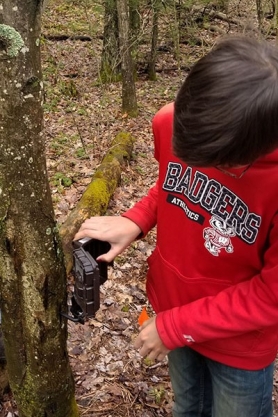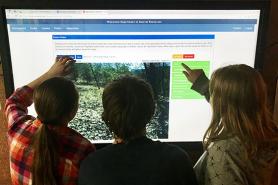Snapshot in the Classroom
Snapshot Wisconsin is a great way to get students of all ages outdoors and learn about local wildlife! The project offers a unique opportunity to integrate science and technology into your classroom or nature center. There are multiple ways to get involved.
Volunteer to host a trail camera [exit DNR] with your students! Snapshot Wisconsin is accepting volunteers statewide. You can deploy a camera at your school forest, nature center or other property. Cameras can be placed on both private and public lands (with permission from the land manager).
If you are unable to host a trail camera or if your students can't get enough of Wisconsin wildlife, you can help identify and count species in photos captured across the state by visiting our Zooniverse crowdsourcing site [exit DNR]. Zooniverse also has a Talk board [exit DNR] where you can connect with fellow educators and our research staff.
If you are looking for another interactive activity for your students, check out the Snapshot Wisconsin Data Dashboard [exit DNR]. On the dashboard, you can visualize, explore and download data collected from Snapshot Wisconsin's statewide network of trail cameras.
Snapshot Wisconsin also has an Educator's Bulletin. The bulletin is a great way to see how fellow educators are using Snapshot in their classrooms. Sign up for the following topic on GovDelivery.
- Snapshot Wisconsin Educator's Bulletin – Sign up for emails about using Snapshot in the classroom and outreach settings.
Lesson Plans
captured on a Snapshot Wisconsin camera
Snapshot Wisconsin lesson plans have been designed for students of all ages and are available free to educators, whether or not they are hosting a trail camera! These lessons are a great way to incorporate exciting concepts about Wisconsin wildlife into your classroom, all while meeting Wisconsin Standards for Science.
Do you have ideas for lesson plans or how to integrate Snapshot Wisconsin into classrooms? We want to hear about it! We are actively generating new lesson plans to reach across more subject areas, including math and English. Submit ideas or lesson plans to the Snapshot Wisconsin team.
Grades K-5
Animal alphabet
A slideshow showcasing Wisconsin wildlife themes for every letter of the alphabet (example questions and animal call sound bites included).
Wildlife Detectives
Students use a series of sounds, patterns and tracks to solve "mystery scenes" of Wisconsin wildlife.
Colorful Critters
An interactive slideshow where students infer the life history of Wisconsin critters using the colors and patterns of their coats.
Schoolyard Stewards
Students explore the human impacts that their own schoolyard is experiencing from air, soil and water pollution.
Wildlife Biodiversity
5th-grade students use beads and dice to explore impacts on biodiversity and the survival of wildlife species.
Grades 6-8
Data Dashboard Scavenger Hunt
Using Snapshot Wisconsin's Data Dashboard, students will practice interpreting maps and graphs and will connect their findings to the ecology of Wisconsin's wildlife.
- Educator handout
- Bear student handout
- Deer student handout
- Sandhill crane student handout
- Student Map
- Answer Key(s)
Displaying Data
Using Snapshot Wisconsin examples, students will identify appropriate data displays for different types of wildlife data.
Creating Chains And Webs To Model Ecological Relationships
Students identify local producers and consumers to generate food webs using a series of "Snapshot Cards."
Making Observations
Students use a series of Snapshot Wisconsin photos to make observations about animal behavior across time and space.
Schoolyard Stewards
Students explore the human impacts that their own schoolyard is experiencing from air, soil and water pollution.
Trophic Cascades
Using a series of habitat and animal cards, students replicate local and global food chains to discuss the impact of trophic cascades.
Grades 9-12
Data Dashboard Scavenger Hunt
Using Snapshot Wisconsin's Data Dashboard, students will practice interpreting maps and graphs and will connect their findings to the ecology of Wisconsin's wildlife.
- Educator handout
- Bear student handout
- Deer student handout
- Sandhill crane student handout
- Student Map
- Answer Key(s)
Creating Chains And Webs To Model Ecological Relationships
Students identify local producers and consumers to generate food webs using a series of "Snapshot Cards."
Trophic Cascades
Using a series of habitat and animal cards, students replicate local and global food chains to discuss the impact of trophic cascades.
Wisconsin Critter Count
Students learn about how the DNR monitors otters and uses a model to replicate sample versus total counts of populations.
Measuring Biodiversity
Students manipulate real Snapshot Wisconsin data to measure different biodiversity indices and compare across ecoregions.
Flashcards
Print and cut out these Snapshot Wisconsin flashcards to test your wildlife identification skills. Sheets are formatted to be printed on both sides.
Activities
The following informal activities are not based on the Wisconsin Academic Standards but were designed as a way to engage students inside or outside of the classroom.
*Slideshows are also available as PowerPoint presentations. Reach out to the team if you would like us to send one to you!


